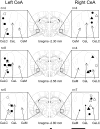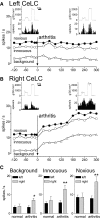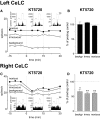Hemispheric lateralization of pain processing by amygdala neurons
- PMID: 19625541
- PMCID: PMC2776996
- DOI: 10.1152/jn.00166.2009
Hemispheric lateralization of pain processing by amygdala neurons
Abstract
Recent biochemical and behavioral data suggest right-hemispheric lateralization of amygdala functions in pain. Our previous electrophysiological studies showed pain-related neuroplasticity in the latero-capsular division of the central nucleus of the amygdala (CeLC) in the right brain hemisphere. Here we determined differences in the processing of pain-related signals in right versus left CeLC neurons. Individual CeLC neurons were recorded extracellularly before and after induction of an arthritis pain state in anesthetized rats. Brief innocuous and noxious test stimuli were applied to peripheral tissues ipsi- and contralateral to the recording site. A monoarthritis was induced in the ipsi- or contralateral knee by intraarticular injections of kaolin and carrageenan. Under normal conditions, CeLC neurons in the left amygdala had smaller receptive fields than those in the right, but the magnitude of background and evoked activity was not significantly different. After arthritis induction, neurons in the right, but not left, CeLC developed increased background activity and evoked responses, irrespective of the location of the arthritis (ipsi- or contralateral to the recording site). A protein kinase A (PKA) inhibitor decreased the activity of right CeLC neurons after arthritis induction but had no effect in the left amygdala. Forskolin, however, increased the activity of left and right CeLC neurons under normal conditions. The results show for the first time laterality of pain-related electrophysiological activity changes in individual amygdala neurons. Whereas both left and right amygdala neurons receive nociceptive inputs and can become sensitized in principle, a yet unknown mechanism prevents PKA activation and pain-related changes in the left amygdala.
Figures


 , high-threshold receptive fields, stimulation of which activated the neuron weakly. i.l., ipsilateral; c.l., contralateral to recording site. A: under normal conditions, receptive fields of right CeLC neurons (n = 15) were symmetrical in the deep tissue of both hindlimbs and the tail (n = 7, left) or covered the whole body (n = 8, right). B: receptive fields of left CeLC neurons (n = 17) were either confined to the contralateral hindlimb (n = 9) or included an additional high-threshold receptive field in the ipsilateral hindlimb (n = 8). C: semi-quantitative analysis of the receptive field size in neurons that were recorded continuously before and after arthritis induction. The body map was divided into 21 areas (A and B, - - -). The total number of areas that contained part of the receptive field was calculated for each neuron and averaged for left (n = 11) and right (n = 9) CeLC neurons (see Data analysis). Only neurons that were recorded before and after arthritis induction are included in the analysis. In the graph, each box extends from the 25th to the 75th percentile, with a line at the median (50th percentile). The whiskers extend above and below the box to show the highest and lowest values. ***, P < 0.0005 (receptive field size of right compared with left CeLC neurons; Mann-Whitney U test), #, P < 0.025 (receptive field size after arthritis compared with normal; Wilcoxon signed-rank test), alpha level adjusted for multiple comparisons.
, high-threshold receptive fields, stimulation of which activated the neuron weakly. i.l., ipsilateral; c.l., contralateral to recording site. A: under normal conditions, receptive fields of right CeLC neurons (n = 15) were symmetrical in the deep tissue of both hindlimbs and the tail (n = 7, left) or covered the whole body (n = 8, right). B: receptive fields of left CeLC neurons (n = 17) were either confined to the contralateral hindlimb (n = 9) or included an additional high-threshold receptive field in the ipsilateral hindlimb (n = 8). C: semi-quantitative analysis of the receptive field size in neurons that were recorded continuously before and after arthritis induction. The body map was divided into 21 areas (A and B, - - -). The total number of areas that contained part of the receptive field was calculated for each neuron and averaged for left (n = 11) and right (n = 9) CeLC neurons (see Data analysis). Only neurons that were recorded before and after arthritis induction are included in the analysis. In the graph, each box extends from the 25th to the 75th percentile, with a line at the median (50th percentile). The whiskers extend above and below the box to show the highest and lowest values. ***, P < 0.0005 (receptive field size of right compared with left CeLC neurons; Mann-Whitney U test), #, P < 0.025 (receptive field size after arthritis compared with normal; Wilcoxon signed-rank test), alpha level adjusted for multiple comparisons.



Similar articles
-
PKA and ERK, but not PKC, in the amygdala contribute to pain-related synaptic plasticity and behavior.Mol Pain. 2008 Jul 16;4:26. doi: 10.1186/1744-8069-4-26. Mol Pain. 2008. PMID: 18631385 Free PMC article.
-
Differential changes of group II and group III mGluR function in central amygdala neurons in a model of arthritic pain.J Neurophysiol. 2006 Oct;96(4):1803-15. doi: 10.1152/jn.00495.2006. Epub 2006 Jun 7. J Neurophysiol. 2006. PMID: 16760343
-
Differential effects of CRF1 and CRF2 receptor antagonists on pain-related sensitization of neurons in the central nucleus of the amygdala.J Neurophysiol. 2007 Jun;97(6):3893-904. doi: 10.1152/jn.00135.2007. Epub 2007 Mar 28. J Neurophysiol. 2007. PMID: 17392412
-
Left and right hemispheric lateralization of the amygdala in pain.Prog Neurobiol. 2021 Jan;196:101891. doi: 10.1016/j.pneurobio.2020.101891. Epub 2020 Jul 28. Prog Neurobiol. 2021. PMID: 32730859 Free PMC article. Review.
-
Neurogenic influences in arthritis.Ann Rheum Dis. 1990 Aug;49(8):649-52. doi: 10.1136/ard.49.8.649. Ann Rheum Dis. 1990. PMID: 2204315 Free PMC article. Review. No abstract available.
Cited by
-
Sensorimotor and Pain Modulation Brain Abnormalities in Trigeminal Neuralgia: A Paroxysmal, Sensory-Triggered Neuropathic Pain.PLoS One. 2013 Jun 18;8(6):e66340. doi: 10.1371/journal.pone.0066340. Print 2013. PLoS One. 2013. PMID: 23823184 Free PMC article.
-
Cross-frequency coupling in deep brain structures upon processing the painful sensory inputs.Neuroscience. 2015 Sep 10;303:412-21. doi: 10.1016/j.neuroscience.2015.07.010. Epub 2015 Jul 10. Neuroscience. 2015. PMID: 26168707 Free PMC article.
-
Disrupted Functional Connectivity of the Amygdala Predicts the Efficacy of Non-steroidal Anti-inflammatory Drugs in Migraineurs Without Aura.Front Mol Neurosci. 2022 Feb 24;15:819507. doi: 10.3389/fnmol.2022.819507. eCollection 2022. Front Mol Neurosci. 2022. PMID: 35283727 Free PMC article.
-
Predominant synaptic potentiation and activation in the right central amygdala are independent of bilateral parabrachial activation in the hemilateral trigeminal inflammatory pain model of rats.Mol Pain. 2018 Jan-Dec;14:1744806918807102. doi: 10.1177/1744806918807102. Epub 2018 Oct 1. Mol Pain. 2018. PMID: 30270724 Free PMC article.
-
Geometric morphometrics for the study of facial expressions in non-human animals, using the domestic cat as an exemplar.Sci Rep. 2019 Jul 8;9(1):9883. doi: 10.1038/s41598-019-46330-5. Sci Rep. 2019. PMID: 31285531 Free PMC article.
References
-
- Adamec R, Blundell J, Burton P. Role of NMDA receptors in the lateralized potentiation of amygdala afferent and efferent neural transmission produced by predator stress. Physiol Behav 86: 75–91, 2005a - PubMed
-
- Adamec RE, Blundell J, Burton P. Neural circuit changes mediating lasting brain and behavioral response to predator stress. Neurosci Biobehav Rev 29: 1225–1241, 2005b - PubMed
-
- Adolphs R. Neural systems for recognizing emotion. Curr Opin Neurobiol 12: 169–177, 2002 - PubMed
-
- Angrilli A, Mauri A, Palomba D, Flor H, Birbaumer N, Sartori G, di PF. Startle reflex and emotion modulation impairment after a right amygdala lesion. Brain 119: 1991–2000, 1996 - PubMed
-
- Atchley RA, Ilardi SS, Enloe A. Hemispheric asymmetry in the processing of emotional content in word meanings: the effect of current and past depression. Brain Lang 84: 105–119, 2003 - PubMed
Publication types
MeSH terms
Substances
Grants and funding
LinkOut - more resources
Full Text Sources
Other Literature Sources
Medical

